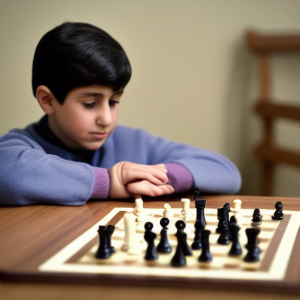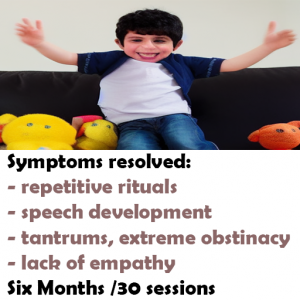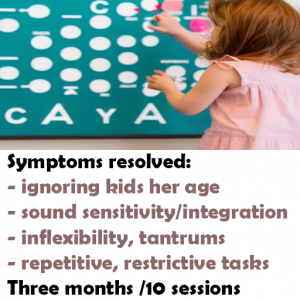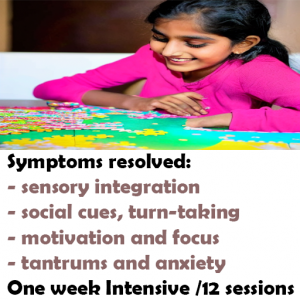Case Study: Tabitha, 3, Autistic Traits
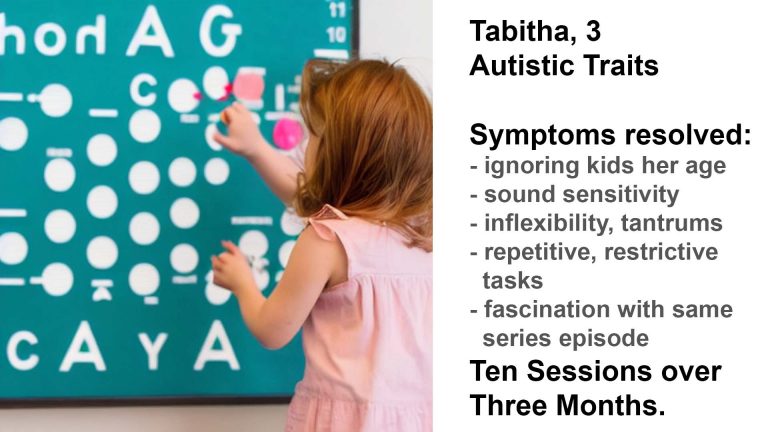
Early Intervention resolves Autistic Traits in Ten Sessions
Before
– Lack of social interests, ignoring kids her age
– sensitivity to sound
– routine and inflexibility, resulting in tantrums
– mild repetitive, restrictive behaviour
– immersion in complex, solitary tasks
Ten Sessions, Weekly, over Three Months
After
– Calmer, relaxed and free of fright and fear
– engages with younger sister
– enjoys morning playgroups, participates actively
– flexible with regard to new iPad content
– unbound by routine
– responds to reason when plans change
– lasting effects and transformed developmental trajectory
Summary:
Tabitha, a 3½-year-old growing up in a bilingual household, exhibited certain concerning behaviors related to her social development, sensitivity to sound, inflexibility, and immersion in complex tasks. Her parents noticed her lack of interest in children her age, sensitivity to loud noises, resistance to changes in plans, and a preference for repetitive activities. Teodora also had limited exposure to and interaction with her younger sister.
Given these concerns, Tabitha’s mother, with a medical background, decided to proactively seek help through neurofeedback training. The training commenced with a brain map session conducted at Tabitha’s home. Her father, who was looking after the two children that day, facilitated the process. Tabitha quickly developed trust and tolerance for the procedure. Her brain map revealed specific areas that needed attention, including emotional sensitivity to auditory input and markers of fear, anxiety, and hypervigilance.
The neurofeedback sessions were tailored to her age and her brain map findings. Tabitha’s initial preference for a single, repetitive cartoon series, “Lule,” posed an issue as it became an essential calming necessity that she demanded to watch repeatedly before going to sleep. In response, the introduction of new content, “Peppa Pig,” helped diversify the content and reduce the obsession with “Lule.” This change marked the beginning of deeper transformations.
Within just five sessions, her father noticed significant improvements in Tabitha’s demeanor. She appeared calmer, more relaxed, and free from fear. Weekend outings and social activities became possible for the family, and Tabitha engaged more with her little sister.
The subsequent five sessions over two months led to substantial changes. Tabitha was more at ease in her playgroup, engaging with other children, showing interest in imaginary play, and displaying improved social skills. After a total of ten sessions, Tabitha’s parents were satisfied with the transformation they had witnessed. Her anxieties had decreased, she was more socially integrated, and her sensitivity to sound was barely noticeable. A follow-up brain map confirmed these positive changes, indicating growth in emotional security, understanding of social rules, respect for personal and social boundaries, reduced hypervigilance, and improved mood control, along with structural maturation. The family celebrated Tabitha’s remarkable progress, highlighting the potential of neurofeedback in early intervention for developmental concerns.
Tabitha's Full Story:
Tabitha is 3½ years old. Growing up in a bilingual household, she was meeting, and often exceeding, many milestones for her age. Certain habits, and social development, were of concern to her parents from age 2, and they expressed this to their GP (medical doctor). He advised them to wait another two or three years before applying for an assessment, as her symptoms appeared mild, and she was verbal after all. In particular, by age 3½, her parents were worried about:
• Lack of social interests: Tabitha simply ignored children of her age in the morning playgroup she was attending. They were of no interest to her, there was no eye contact and she appeared to treat them as objects rather than entities with needs and feelings, despite encouragement and gentle guidance. This attitude was also displayed towards her younger sister, though she was never mean to her despite various encroachments on her play domain. By contrast, Tabitha engaged with adults very differently. While shy and reserved, she would let ‘big people’ into her sphere of play, making eye contact when she suspected an opportunity to learn something, gain access to toys and activities she enjoyed, or demonstrated a skill such as getting a keyboard to make sounds, which she commented on in short phrases that were mainly instructions, rather than questions.
• Sensitivity to sound: Tabitha was at ease with music that she liked, and her father’s impressive vinyl collection treated her a wide range of genres, from classical piano concertos to rock of the 70s. She was fascinated by the electric keyboard in her living room, and warmed up to anyone playing it with skill, despite having first voiced her disapproval of new people entering her family home. Louder, and/or unexpected sounds however startled her and could set off an outburst that she would take a while and much comforting to calm down from.
• Inflexibility and mild repetitive, restrictive behaviour: Tabitha was inquisitive though shy, and open to new activities, however when plans did not suit her, she would become obstinate and resistant. Rationalising and negotiation cemented her stance; her temper would flare and it would take significant time, effort and distraction to calm her down again. One such ‘bribe’ involved watching a Romanian children’s series on her iPad, and this was the only show she tolerated; attempts to expand her interests in this regard were met with animosity and outbursts. She could watch the same episode over and over again for hours, curtailment of which would also require significant effort and distraction. While watching it, she was happy and attempted to copy songs and snippets of dialogue.
• Immersion in complex tasks: Less of a concern, but noteworthy, was Tabitha’s ability to solve hundred-piece puzzles, an occupation that would captivate her full attention. Locked in her realm, she would be unphased by activity around her, even sounds or new people in the room, as she would talk to herself while demonstrating remarkable aptitude and drive until she had finished it and would announce this with pride to her proud parents. Tabitha was also able to recognise and differentiate between complex skeletal representations of organic chemistry symbols that her mother had drawn on a board for her own study, a talent the surprised parents would foster with considerable admiration. She was able to navigate an ipad with ease, but would neither share this with her younger sister.
Tabitha’s parents had heard great things about neurofeedback in their home country, and her mother’s medical background strengthened her initiative to be proactive at the earliest stage in her child’s development.
We began with a brain map at Tabitha’s home. Her mother was at work while her father was looking after the two young daughters, and he welcomed the social component of a new person breaking this isolated routine. Tabitha witnessed this rapport and overcame her initial suspicion and resistance quickly. Watching and listening to someone play on the electric keyboard fascinated her, and within an hour she had built up sufficient trust to let a new person put a shower cap-like device on her head. We obtained a qEEG recording that provided the necessary data for analysis.
Tabitha’s brain map showed the refreshing finding that she was open to new perspectives and not relational, or self-centred in her thinking, an important transition that happens between age 3-5. She exhibited various trauma-like markers, including an emotional sensitivity to auditory input, and a sense of feeling underloved or lack of emotional sense of safety. There were various anxiety markers, and confirmation of her hypervigilance, shyness, obstinacy, loner qualities, and mood regulation issues, while being overly primed by her environment. Fear and anxiety were prevalent markers we needed to address while strengthening her Default Mode Network sites.
Following a short snack break, Tabitha tolerated the affixing of four electrodes on her head with a sticky paste while she was watching her favourite (and at this point, only) cartoon series, “Lule”, set on repeat. With protocols adapted to her age and brain map findings, she became noticeably calmer during each session. Her father was initially fully present and involved in the set up, but could soon divert his attention to the younger daughter who was quietly seeking to disrupt the process with her fascination for pulling on cables unnoticed.
Sessions were split into two one-hour segments, interrupted by a short lunch break. Flexibility with time was essential at this stage. There were many sites to work on during the weekly sessions, and it was helpful to be able to do two hours of effective neurofeedback time. By the third session however, we were still watching the same content in a loop, which appeared to create an obsession: Her mother was concerned that this particular cartoon episode became an essential calming necessity that Tabitha demanded in order to go to sleep, and would have to watch at least once a day. The following session, we introduced new content, “Peppa Pig”, which Tabitha happily embraced. This allowed us to at least watch multiple, different episodes during a session, rather than one in a loop. Sufficient to break the obsession with Lule, the ipad was no longer a necessity for going to sleep. It was the beginning of deeper changes.
Within five sessions, her father remarked that he could feel the difference in her demeanour. Sensing that Tabitha was much calmer, relaxed and free of fright and fear, her parents were already happy about the development as a result of their investment. Weekend outings became a possibility that helped the family bond and the parents regain a social life.
We continued with a further five sessions over the course of two months, and by now the results began to show true transformation. Tabitha was engaging with her little sister during play, though with the occasional frustration that her conversation attempts weren’t reciprocated as expected by the young toddler. Carers at her playgroup remarked that she was much easier to handle and was actively engaging with other children. This included indirect communication through imaginary play with toys, such as her favourite pony models that she would encourage others to use and create scenes and dialogue with; taking turns when asked without the usual resistance; joining groups for storytelling without prompt; and referring to some by name.
After ten sessions in total, Tabitha’s parents felt that she was on a new trajectory and were happy about the transformation. They sensed that her anxieties had reduced substantially, shyness had ceded to healthy exploration, and sound sensitivity was barely noticeable. Tabitha was calmer, insightful when changes of plans were explained, and socially integrated. A remap confirmed these substantial changes, including her sense of emotional security, social rules, personal and social boundaries, hypervigilance and mood control. Another metric showed significant structural maturation.

